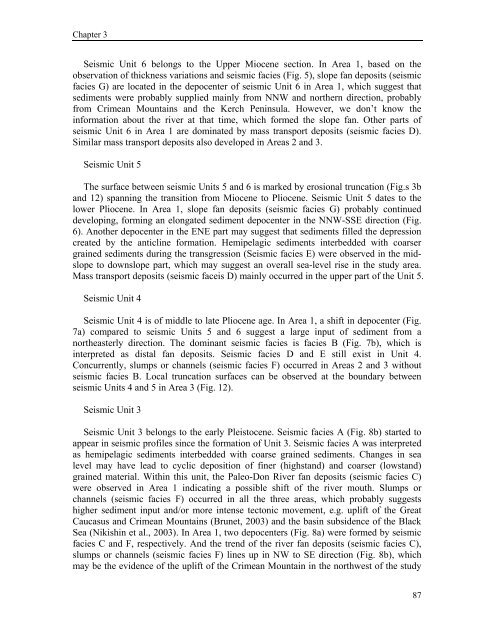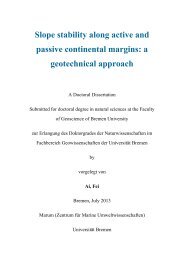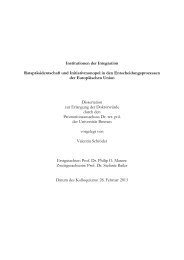Seismoacoustic Study of the Shallow Gas Transport and ... - E-LIB
Seismoacoustic Study of the Shallow Gas Transport and ... - E-LIB
Seismoacoustic Study of the Shallow Gas Transport and ... - E-LIB
You also want an ePaper? Increase the reach of your titles
YUMPU automatically turns print PDFs into web optimized ePapers that Google loves.
Chapter 3<br />
Seismic Unit 6 belongs to <strong>the</strong> Upper Miocene section. In Area 1, based on <strong>the</strong><br />
observation <strong>of</strong> thickness variations <strong>and</strong> seismic facies (Fig. 5), slope fan deposits (seismic<br />
facies G) are located in <strong>the</strong> depocenter <strong>of</strong> seismic Unit 6 in Area 1, which suggest that<br />
sediments were probably supplied mainly from NNW <strong>and</strong> nor<strong>the</strong>rn direction, probably<br />
from Crimean Mountains <strong>and</strong> <strong>the</strong> Kerch Peninsula. However, we don’t know <strong>the</strong><br />
information about <strong>the</strong> river at that time, which formed <strong>the</strong> slope fan. O<strong>the</strong>r parts <strong>of</strong><br />
seismic Unit 6 in Area 1 are dominated by mass transport deposits (seismic facies D).<br />
Similar mass transport deposits also developed in Areas 2 <strong>and</strong> 3.<br />
Seismic Unit 5<br />
The surface between seismic Units 5 <strong>and</strong> 6 is marked by erosional truncation (Fig.s 3b<br />
<strong>and</strong> 12) spanning <strong>the</strong> transition from Miocene to Pliocene. Seismic Unit 5 dates to <strong>the</strong><br />
lower Pliocene. In Area 1, slope fan deposits (seismic facies G) probably continued<br />
developing, forming an elongated sediment depocenter in <strong>the</strong> NNW-SSE direction (Fig.<br />
6). Ano<strong>the</strong>r depocenter in <strong>the</strong> ENE part may suggest that sediments filled <strong>the</strong> depression<br />
created by <strong>the</strong> anticline formation. Hemipelagic sediments interbedded with coarser<br />
grained sediments during <strong>the</strong> transgression (Seismic facies E) were observed in <strong>the</strong> midslope<br />
to downslope part, which may suggest an overall sea-level rise in <strong>the</strong> study area.<br />
Mass transport deposits (seismic faceis D) mainly occurred in <strong>the</strong> upper part <strong>of</strong> <strong>the</strong> Unit 5.<br />
Seismic Unit 4<br />
Seismic Unit 4 is <strong>of</strong> middle to late Pliocene age. In Area 1, a shift in depocenter (Fig.<br />
7a) compared to seismic Units 5 <strong>and</strong> 6 suggest a large input <strong>of</strong> sediment from a<br />
nor<strong>the</strong>asterly direction. The dominant seismic facies is facies B (Fig. 7b), which is<br />
interpreted as distal fan deposits. Seismic facies D <strong>and</strong> E still exist in Unit 4.<br />
Concurrently, slumps or channels (seismic facies F) occurred in Areas 2 <strong>and</strong> 3 without<br />
seismic facies B. Local truncation surfaces can be observed at <strong>the</strong> boundary between<br />
seismic Units 4 <strong>and</strong> 5 in Area 3 (Fig. 12).<br />
Seismic Unit 3<br />
Seismic Unit 3 belongs to <strong>the</strong> early Pleistocene. Seismic facies A (Fig. 8b) started to<br />
appear in seismic pr<strong>of</strong>iles since <strong>the</strong> formation <strong>of</strong> Unit 3. Seismic facies A was interpreted<br />
as hemipelagic sediments interbedded with coarse grained sediments. Changes in sea<br />
level may have lead to cyclic deposition <strong>of</strong> finer (highst<strong>and</strong>) <strong>and</strong> coarser (lowst<strong>and</strong>)<br />
grained material. Within this unit, <strong>the</strong> Paleo-Don River fan deposits (seismic facies C)<br />
were observed in Area 1 indicating a possible shift <strong>of</strong> <strong>the</strong> river mouth. Slumps or<br />
channels (seismic facies F) occurred in all <strong>the</strong> three areas, which probably suggests<br />
higher sediment input <strong>and</strong>/or more intense tectonic movement, e.g. uplift <strong>of</strong> <strong>the</strong> Great<br />
Caucasus <strong>and</strong> Crimean Mountains (Brunet, 2003) <strong>and</strong> <strong>the</strong> basin subsidence <strong>of</strong> <strong>the</strong> Black<br />
Sea (Nikishin et al., 2003). In Area 1, two depocenters (Fig. 8a) were formed by seismic<br />
facies C <strong>and</strong> F, respectively. And <strong>the</strong> trend <strong>of</strong> <strong>the</strong> river fan deposits (seismic facies C),<br />
slumps or channels (seismic facies F) lines up in NW to SE direction (Fig. 8b), which<br />
may be <strong>the</strong> evidence <strong>of</strong> <strong>the</strong> uplift <strong>of</strong> <strong>the</strong> Crimean Mountain in <strong>the</strong> northwest <strong>of</strong> <strong>the</strong> study<br />
87
















